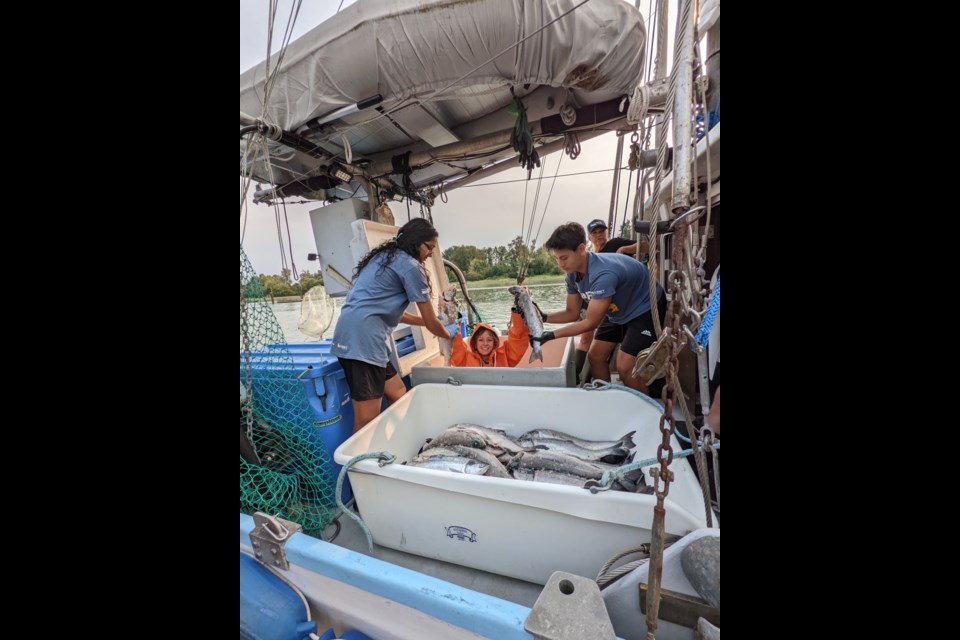A cookout using Fraser River sockeye salmon was held in Steveston yesterday to thank all those involved in salmon habitat restoration.
Students, members of hatcheries, streamkeeping societies and non-profits, as well as politicians gathered at the docks to have a taste of the fruits of their hard work, made specially by chef and Order of Canada recipient Robert Clark.
Credit for the idea, said Clark, should be given to co-founder of Organic Ocean and chair of BC Salmon Marketing Council Dane Chauvel.
“There are just so many groups… that are connected to [the restoration of wild Pacific salmon]… and [Chauvel] realized there’s so many that go unnoticed or unappreciated or unrecognized,” he said.
These groups include Pacific Salmon Foundation, Ocean Wise Conservation Association, David Suzuki Foundation, SeaChoice, RiverWatch, Watershed Watch Salmon Society and students employed by the Salmon Habitat Restoration Program (SHaRP). SHaRP is a student-based initiative from Surrey that began in 1996.
Apart from recognizing their efforts, it was also a chance to bring all sectors of salmon stewardship together and share their work.
“It’s one of those things where maybe the folks who are doing the sustainable fishing don’t know about the work that happens in the local streams to care for the young, juvenile salmon. And vice versa,” explained Liana Ayach, an environmental technologist for SHaRP.
“It’s really important to get that holistic knowledge of the full cycle, what’s going on and what everybody’s trying to do.”
“A phenomenal product”
The cookout was a rare opportunity for those dedicated to the conservation and restoration of Fraser River sockeyes to taste the fish since commercial fishing is once again closed despite a stronger run compared to last year’s.
The salmon served at the cookout were test fish obtained to measure the health and stock of the species. Results of test fishing are used by the Fraser River Panel of the Pacific Salmon commission to determine whether commercial fisheries would open in case populations are too low.
According to Business in Vancouver, the latest run size estimate in August for this year’s run is about 5.5 million, which is about half of the pre-season forecast of 9.8 million. 2.5 million fish had returned in 2021.
Fraser River sockeye is “a phenomenal product,” explained Clark, as its oil content is much higher than most sockeyes. Unlike most sockeyes which tend to dry out easily if they’re overcooked, Fraser River sockeyes are “so rich and fatty” that they stay “incredibly lush.”
Clark seasoned the salmon with salt and pepper and served it right off the barbecue with a sweet lemon preserve. Participants also enjoyed fresh salads and delicious fish-shaped desserts.
“A wonderful culmination”
It’s “incredibly important” to recognize volunteers and SHaRP students, said Ayach.
Volunteers are the “lifeblood” of a lot of small tributary streams, and it’s the first time for a lot of the students, who are also working for the first time, to be able to connect with the community and learn about the work that’s going on, she explained.
“It’s not like there are reports in the news day in and day out of how many fish have been saved. We have the traffic reports but we don’t get, you know, environmental protection reports,” said Ayach.
“It was amazing to attend the event as it felt like a wonderful culmination to a successful season of salmon habitat restoration and stewardship,” said Madeleine Wasmuth, university student and SHaRP media and public relations leader for spring and summer of 2022.
SHaRP students had been helping restore the riparian areas by “removing invasive plant species, planting native plants, and installing rock features as well as spawning gravel in order to assist the salmon population’s continued growth and success rate,” said Wasmuth.
“I loved the opportunity to help take the sockeye salmon out of the boat’s hull and then see (and taste!) the end result.”
After participating in the program and meeting people from all aspects of salmon habitat restoration, Wasmuth thinks it’s important for everyone to get a chance to participate in protecting wild salmon and to continue programs such as SHaRP.
“What I learned from the event is that it would be a dream for all municipalities to take up initiatives such as SHaRP in order to advocate for salmon stewardship and habitat restoration.
“But in order to do so, it takes an army,” she said.
Clark is also hopeful that Richmond and other cities will be inspired and come up with city-led programs just like Surrey.
Parm Bains, MP for Steveston-Richmond East, noted that the federal government is “working hard” to do their part in “ensuring that the industry thrives” and said that he would love to see Richmond do something similar to the SHaRP program.
“If I can do something to encourage one of our high schools or our school district to come together and be a part of the SHaRP program, and also do something similar here in Richmond, I’d love to see that,” he said.




